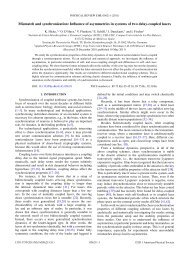DBI Analysis of Open String Bound States on Non-compact D-branes
DBI Analysis of Open String Bound States on Non-compact D-branes
DBI Analysis of Open String Bound States on Non-compact D-branes
You also want an ePaper? Increase the reach of your titles
YUMPU automatically turns print PDFs into web optimized ePapers that Google loves.
CHAPTER 2. BOSONIC STRINGS 20which c<strong>on</strong>firms our claim for p µ . Furthermore, simply applying the definiti<strong>on</strong> <str<strong>on</strong>g>of</str<strong>on</strong>g> anaverage to X µ (σ), we see that1π∫ π0dσX µ (σ, τ) = x µ + l 2 sp µ τ, (2.38)indicating that x µ is the center <str<strong>on</strong>g>of</str<strong>on</strong>g> mass positi<strong>on</strong> at time τ = 0. Note that x µ and p µare arbitrary, i.e. if we wanted to we could explicitely fill them in, thereby specifying aninitial positi<strong>on</strong> and momentum for our string.2.5.2 <str<strong>on</strong>g>Open</str<strong>on</strong>g> string expansi<strong>on</strong>A feature present in all open string expansi<strong>on</strong>s is that <strong>on</strong>ly <strong>on</strong>e set <str<strong>on</strong>g>of</str<strong>on</strong>g> expansi<strong>on</strong> coefficientsα is present. Before giving the expansi<strong>on</strong>s, this can already be understoodby realizing that whilst the closed strings allow oscillati<strong>on</strong>s in two directi<strong>on</strong>s, in thecase <str<strong>on</strong>g>of</str<strong>on</strong>g> open strings left- and right-movers need to combine into standing waves due toreflecti<strong>on</strong>s at their endpoints, hence leaving <strong>on</strong>ly <strong>on</strong>e set <str<strong>on</strong>g>of</str<strong>on</strong>g> coefficients.Dirichlet boundary c<strong>on</strong>diti<strong>on</strong>sThe wave equati<strong>on</strong>s for an open string satisfying Dirichlet boundary c<strong>on</strong>diti<strong>on</strong>s can beexpanded as∑X µ (σ, τ) = x µ + w µ 1σ − l sn αµ ne −inτ sin(nσ), (2.39)with again µ ≠ 0. We need sin(nσ), and not cos (nσ), in order to accomodate thevanishing <str<strong>on</strong>g>of</str<strong>on</strong>g> the oscillators in the endpoints. The c<strong>on</strong>stant w µ is called the windingnumber <str<strong>on</strong>g>of</str<strong>on</strong>g> the string. Note thatn≠0X µ (σ = π, τ) − X µ (σ = 0, τ) = w µ π, (2.40)and hence w µ encodes the distance between both endpoints. We will come back to thiswhen we will c<strong>on</strong>sider T-duality and D-<strong>branes</strong>.Neumann boundary c<strong>on</strong>diti<strong>on</strong>sFor an open string satisfying Neumann boundary c<strong>on</strong>diti<strong>on</strong>s, the expansi<strong>on</strong> readsX µ (σ, τ) = x µ + l 2 sp µ τ + il s∑n≠01n αµ ne −inτ cos (nσ). (2.41)Note that this time we need cos (nσ), so that the ∂ σ derivatives will vanish at theendpoints. Also note that since no momentum can flow <str<strong>on</strong>g>of</str<strong>on</strong>g> the ends <str<strong>on</strong>g>of</str<strong>on</strong>g> the string, we canagain talk about a center <str<strong>on</strong>g>of</str<strong>on</strong>g> mass momentum p µ .This time, we can define the zero-mode asα µ 0 = l sp µ . (2.42)
















